Current exhibition: Ca' Foscari and its university theatre
This small exhibition, through documents and publications, revisits key moments in the history of university theatre at Ca’ Foscari, highlighting one of the post-war initiatives that gained significant success from the 1950s to the 1970s.
The idea of establishing a university theatre company was proposed by Giovanni Poli (1917–1979), a secondary school teacher with a passion for theatre. It was supported by the Rector, Gino Luzzatto, who in the spring of 1950 endorsed the project and presented it to the University’s Board of Governors (Scannapieco, p. 46). Within just two years, the group of young actors—guided by the strong personality of their artistic director and stage director—had achieved such success that in 1953 the company was mentioned in the inaugural speech for the academic year delivered by Italo Siciliano. In the spring of that same year, the company started touring abroad, earning praise at the Erlangen Festival with their production of the anonymous sixteenth-century play La Venexiana.
From its impromptu beginnings in spaces temporarily repurposed as performance venues, such as the main lecture hall, to gaining international acclaim through festivals, tours, and awards, by 1960 the Ca’ Foscari theatre company had completed twenty-six international tours, visiting every country in Western Europe. At a time when the Erasmus Programme was still unimaginable, being part of such a dynamic theatre group must have felt special for many students. Within the limited space of this exhibition, we have decided to showcase the story of Ca’ Foscari’s theatre journey in two parts: the first display case emphasises key moments of the Theatre in Venice, while the second revisits aspects of its international history.
SHOWCASE 1 – Ca’ Foscari University Theatre in Venice
1 - University Theatre: Allocation of Funds for a Permanent Venue, 1952
During the Board of Governors meeting on 27 September 1952, Rector Gino Luzzatto officially inaugurated a new chapter titled “University Theatre” to allocate funds—specifically one million lire—for converting the “entrance hall of Palazzo Giustinian dei Vescovi” into a permanent theatre venue. The budget encompassed both the stage area and the audience space, including the purchase of chairs.
Archive, Minutes of the Board of Governors Meetings, session of 27 September 1952, pp. 150–151.
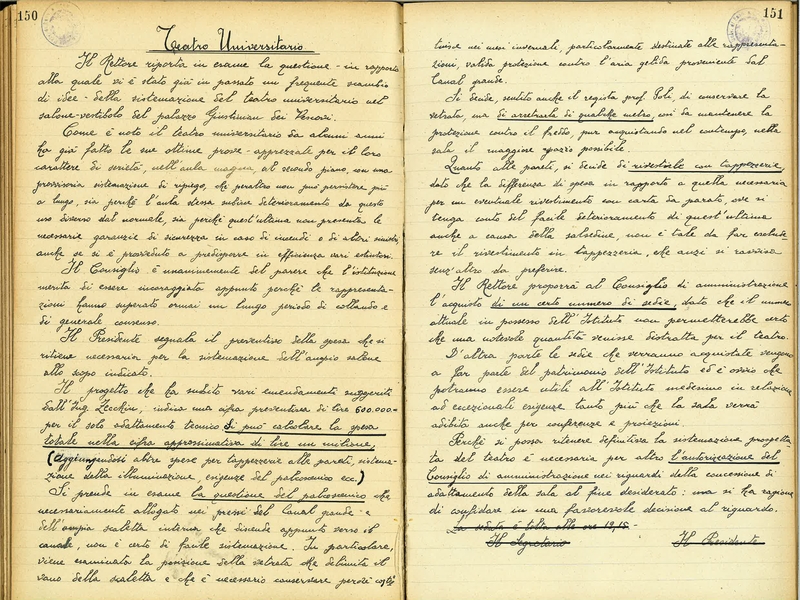
2 - Photographs of the Entrance and Theatre at Palazzo Giustinian dei Vescovi
These facsimile photographs, taken from the volume Dieci anni di un teatro Universitario edited by Giovanni Poli, show the entrance to the theatre from Ca’ Foscari’s smaller courtyard. The entrance is marked by two cases displaying the poster-sized playbills of the performances. The caption accompanying the image of the auditorium provides a wealth of detail: “The Ca’ Foscari theatre contains, although on a smaller scale, all the fundamental elements necessary for such a facility: a stage with a revolving platform enabling on-stage scene changes and a modern projection lighting system; a hall upholstered with artistic Fortuny fabrics and stylish Venetian-style wall sconces; an auditorium with 210 folding seats arranged on a sloped floor to provide optimal visibility; a bar, an office for production management, dressing rooms, toilets for both audience and performers, a cloakroom, and various storerooms for stage sets. Thanks to this generous act of understanding and trust by the University, Ca’ Foscari students now have access to a permanent ‘stage studio,’ hosting significant theoretical and stagecraft activities.” (G. Poli, 1959, p. 13)
Reproductions of photographs published in Dieci anni di un teatro Universitario, edited by G. Poli, Venice, 1962, pp. 12–13. (Historical Collection, BG MISC A 1167)
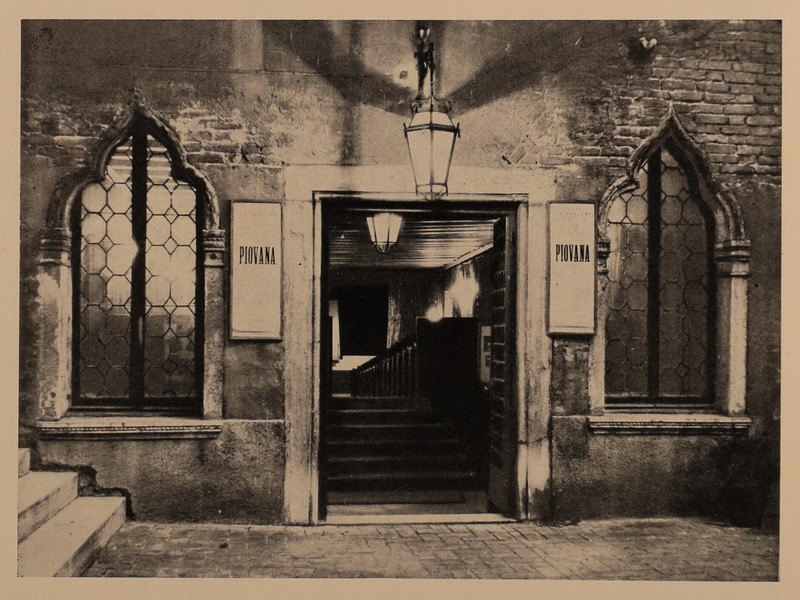
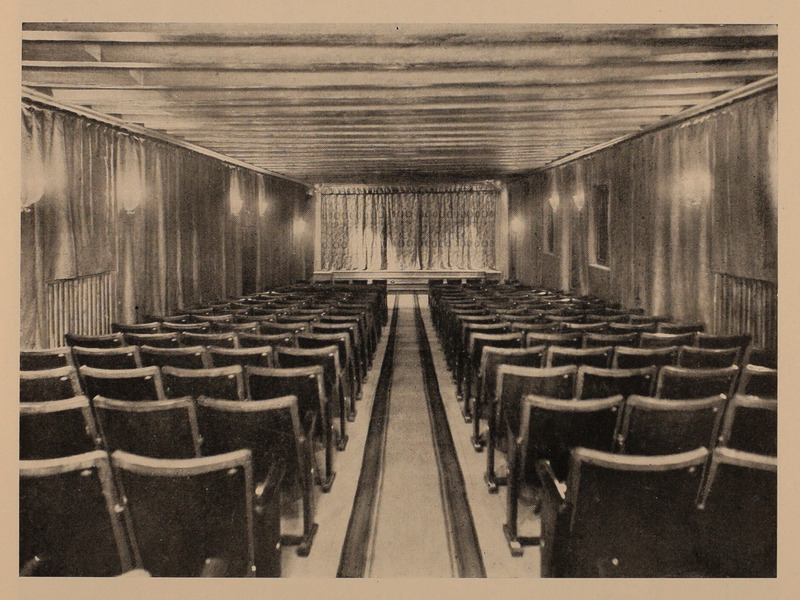
3 - Le Massere – Première on 21 March 1953, for the Inauguration of the New Venue at Palazzo Giustinian
To inaugurate the university’s new theatre venue, director Giovanni Poli chose to stage a forgotten masterpiece by Goldoni—Le Massere (The Maids)—which was met with unexpected public acclaim: around twenty performances followed the premiere. A few months later, the same production was taken to the International University Theatre Festival in Parma, and in 1955 it went on tour to the Erlangen festival and to Zagreb, as part of an exchange with the Yugoslav university.
On display here is the theatre programme of Le Massere, containing Giovanni Poli’s directorial notes. It is opened on the page recording the première (1953), alongside a photograph of the lead actresses.
Goldoni, C. (1962). Le Massere: Commedia. Directorial notes by Giovanni Poli, University Theatre Series (4) – Ca’ Foscari Venice, La Tipografica. (Historical Collection, BG Misc B.6101)
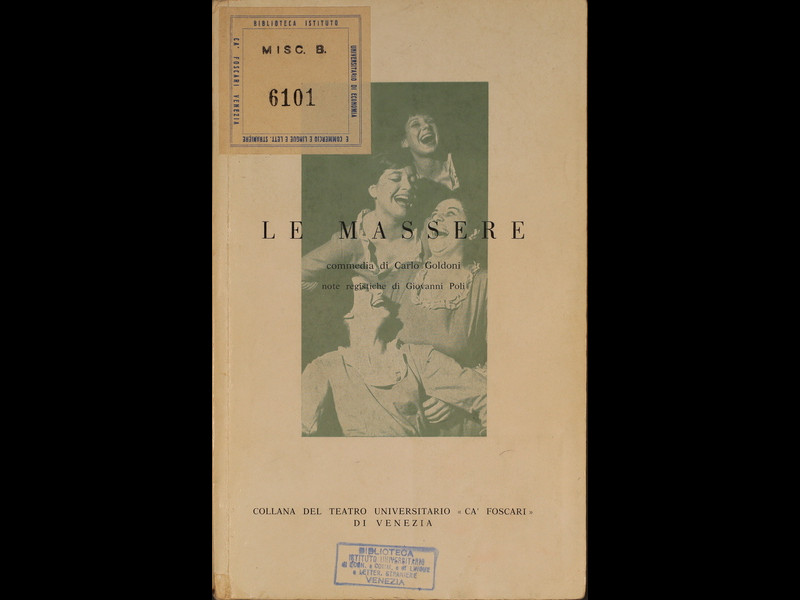

4 - Laudes Evangeliorum, Première for the Venice Biennale: 1956
a. Press Coverage – In the summer of 1956, just a few years after the official founding of the Ca’ Foscari University Theatre Company, Giovanni Poli directed a sacred play based on anonymous 14th-century Perugian texts. It was staged to close the 15th International Festival of Spoken Theatre at the Venice Biennale. The facsimile press clippings on display here reproduce three articles from a local newspaper, Il Gazzettino:
- 31 July and 1 August 1956: promotional pieces with details about the venue (the courtyard of Ca’ Foscari), the cast, the production crew, and ticket information.
- 2 August 1956: a review signed “bert.” celebrating the success of the première, which involved around sixty participants—including Ca’ Foscari actors, the Arsenale polyphonic choir, and young dancers from the School of Classical Dance led by Mariella Turitto Alessandri.
The success of this production and Parma’s International University Theatre Festival inspired the Biennale to create a dedicated section for university theatre in 1957. This new format aimed to bring emerging student theatre groups into dialogue with “the leading professional ensembles in Europe” (Gabrielli, 1957, in Scannapieco, p. 68, note 84). According to Biennale archives, the last Ca’ Foscari theatre production to appear in the festival was in 1974.
b. The two-act sacred play Laudes Evangeliorum, adapted from anonymous 14th-century Perugian texts by Giovanni Poli, inaugurated the University Theatre Series Ca’ Foscari of Venice. The series, published between 1959 and 1963 under Poli’s direction, aimed to showcase the company’s most original productions and consisted of seven monographs. Released in limited print runs, the volumes were typographically designed by Edoardo Andreotti Loria and printed by La Tipografica in Venice. These small books include the full script or performance outline (depending on the work), as well as stage photographs, musical scores, and set design sketches.
Image 1: Facsimile of press clippings from the Press Review Archive
Image 2: Laudes Evangeliorum. Sacra rappresentazione based on anonymous 14th-century Perugian texts, curated by Giovanni Poli. University Theatre Series (1) – Ca’ Foscari Venice, La Tipografica. (Historical Collection, BG Misc B.6100)
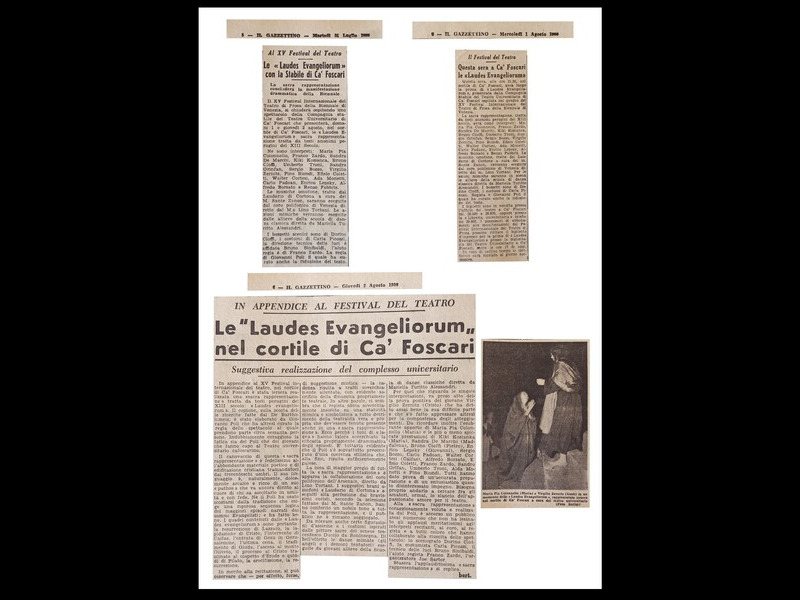
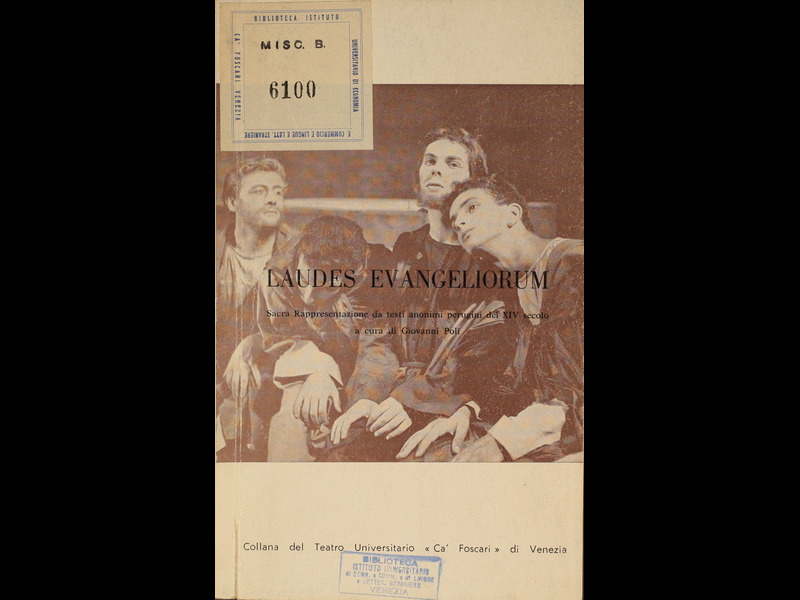
5 - Il Gazzettino, 29 October 1967: War Veterans protest over the staging of Il reduce by Ruzante
In 1965, after Giovanni Poli’s decade-long success as artistic director, the university theatre's leadership shifted to Renato Padoan and a group of young intellectuals. They represented a spirit of innovation and dissent, foreshadowing the restlessness and protests that would define the late 1960s.
This article from Il Gazzettino documents one of the controversies faced by the new artistic direction. In October 1967, even before the play was staged, Ca’ Foscari’s student theatre group came under attack for alleged disrespect towards associations of war veterans and former soldiers of the First World War. The criticism arose because the characters in Il reduce wore Italian military uniforms from that era. The university remained steadfast and refused to comply with calls for censorship. The play proceeded as scheduled in March 1968, accompanied by public talks and debates.
Original clipping from the Archive, Miscellaneous, University Theatre section
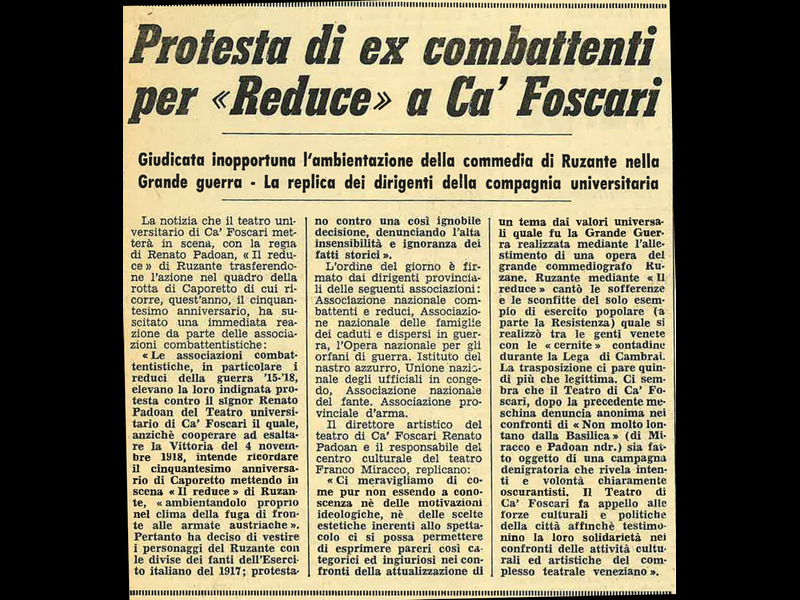
6 - Torotumbo di Miguel Angel Asturias (1899-1974)
On 3 April 1970, the Ca’ Foscari theatre group — which by then was increasingly aiming to link its artistic work with the university’s teaching and research activities — staged a performance of Torotumbo in the presence of the author, Miguel Angel Asturias, who had been invited as guest of honour.
Miguel Ángel Asturias, Guatemalan, had received the Nobel Prize for Literature in 1967. Torotumbo was an allegorical text, blending magical folklore with social critique. Although a degree programme in Latin American literature was formally established at Ca’ Foscari only in 1975, with Professor Giuseppe Bellini appointed to the chair, such cultural initiatives involving the wider university community helped reinforce the value of Ca’ Foscari’s academic network and underscored the theatre group’s intellectual vitality. In 2018, as part of Ca’ Foscari’s 150th anniversary celebrations, the Fucina delle Arti Performative paid tribute to Miguel Ángel Asturias with a new performance that also recalled the speech he gave upon receiving an honorary degree from Ca’ Foscari in 1972.
First edition, in Spanish, of the novel Torotumbo, 1967. BALI Library (Ca’ Bernardo): IBERIS A P 104
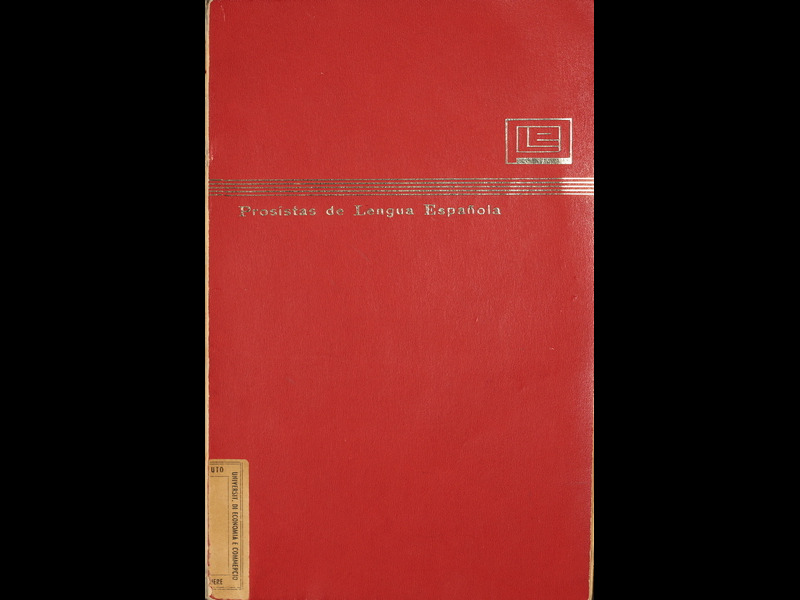
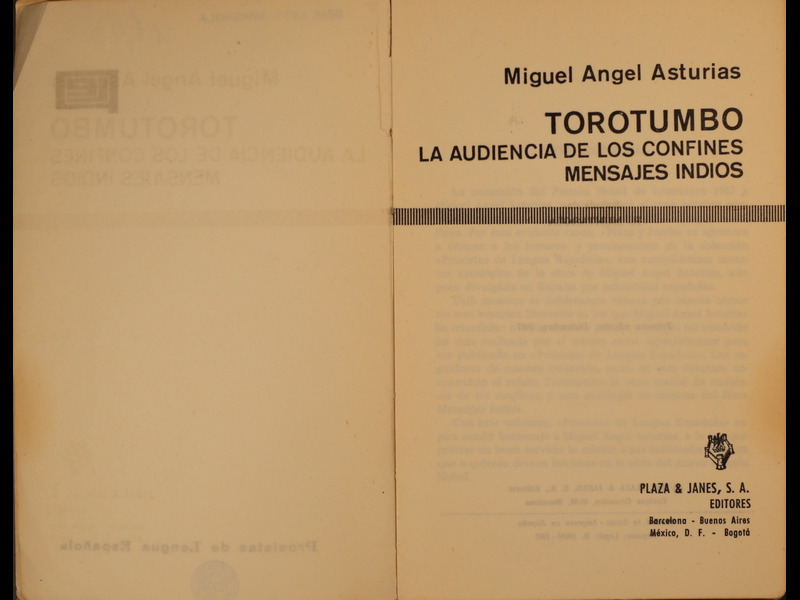
SHOWCASE 2 – Ca’ Foscari Theatre on Tour
7 - L’Augellin Belverde: An International Success
a. This leaflet advertises the Festival International du Théâtre Universitaire, held in Bruges, Belgium, where Ca’ Foscari’s theatre company performed L’Augellin belverde, a two-act adaptation of a philosophical fable by Carlo Gozzi. The production was met with critical and public acclaim. The Gazzetta di Mantova—published in the Italian city where the play premiered in autumn—quoted excerpts from the Belgian press:
“The extraordinary virtuosity of these actors, who dance their scenes before even speaking them, using their entire bodies to express the text, with such precision of movement that the audience has no chance to relax.” (“L’Augellin belverde” di Gozzi nei giudizi della critica belga”, Gazzetta di Mantova, 9 October 1954)
In his preface to the published script, director Giovanni Poli writes: “The text presented here is a theatrical adaptation rich in cuts, transformations, scenic construction, and scriptwriting. It is, therefore, Gozzi reinterpreted through a modern sensibility, and an open critique of the still-dominant theatrical conditions in Italy, which continue to foster aesthetic confusion and a decline in audiences.”
This production became one of Ca’ Foscari Theatre’s flagship pieces, and was presented on several tours, including in New York in 1962 at the Institute for Advanced Studies in the Theatre Arts (IASTA) (see Scannapieco, Il teatro di Ca’ Foscari, 2006, p. 77).
b. The musical appendix – On display here is the third volume of the University Theatre Series, opened to the musical appendix by Lino Tortani. The instruments used in the “intermezzi” include: flute, oboe, clarinet, bassoon, horn, trombone, vibraphone, metal plate, suspended cymbals, triangle, drums, and bass drum.
Images 1 and 2: Festival International du Théâtre Universitaire leaflet, 22–29 July 1954. Archive, Wooden Boxes 39/6
Images 3 and 4: L’Augellin belverde (The Green Bird). Philosophical fable by Carlo Gozzi. Scenario and two-act adaptation by Giovanni Poli. University Theatre Series (3) – Ca’ Foscari Venice, La Tipografica. (Historical Collection, BG Misc B.6099)
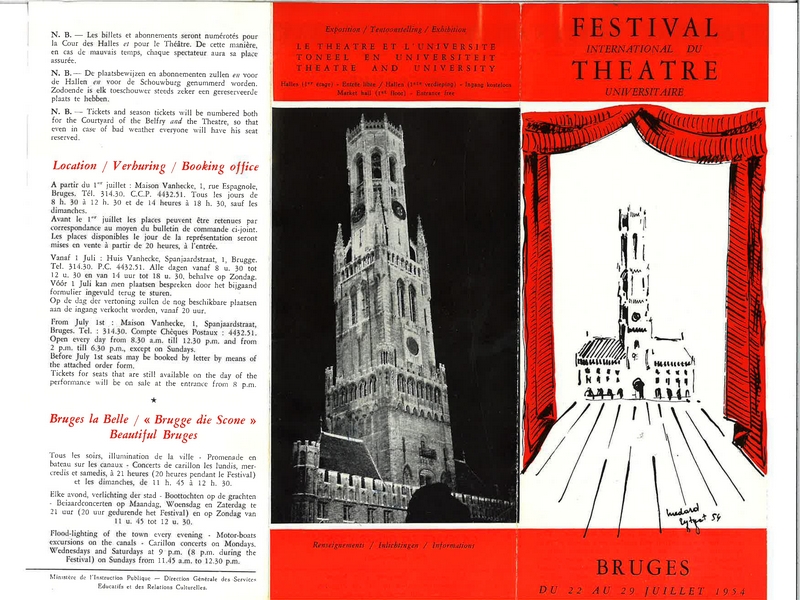
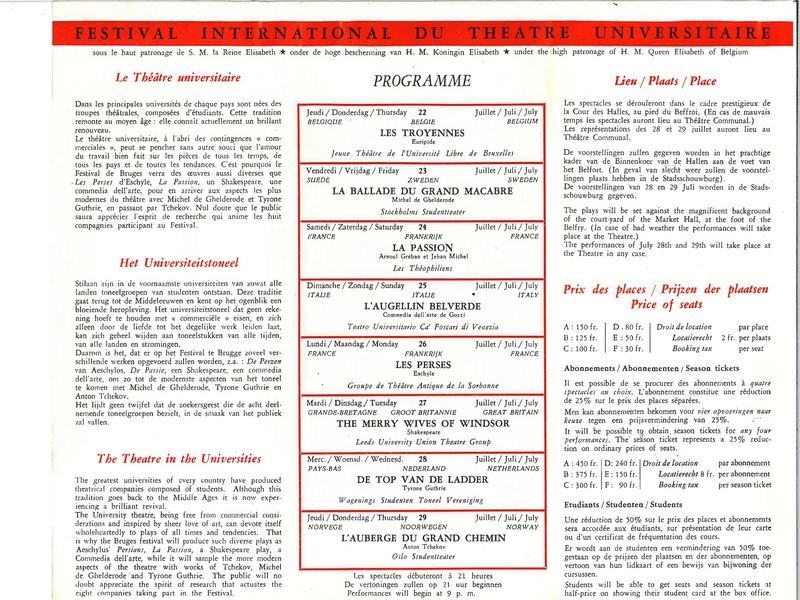
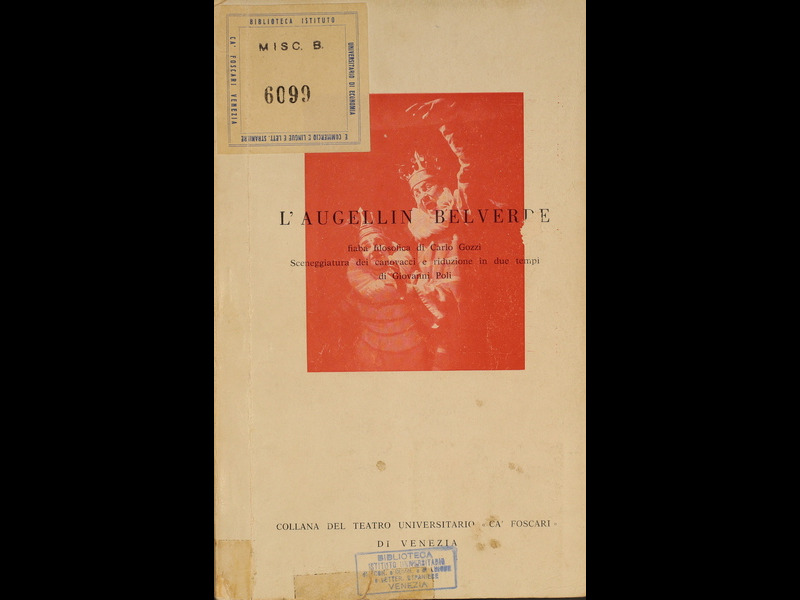
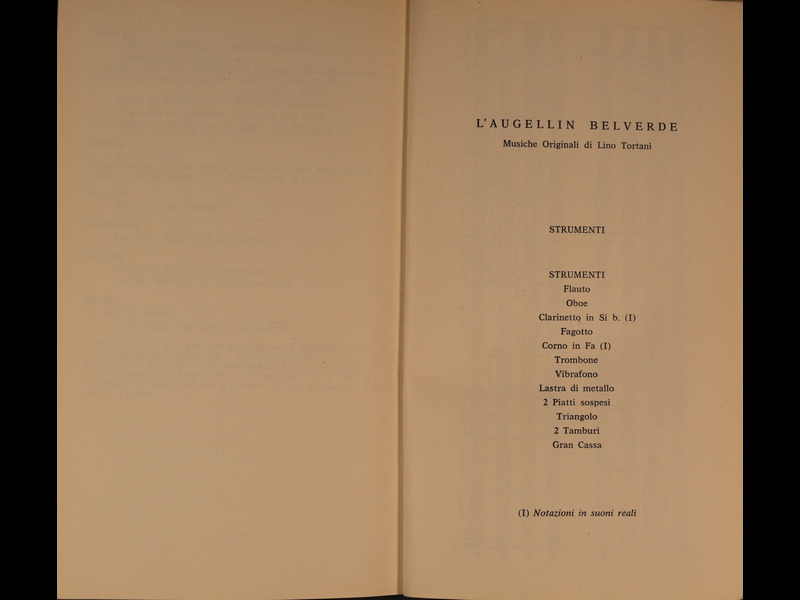
8 - La commedia degli Zanni: Commedia dell’Arte reimagined
Presented on 29 April 1958 at the University Theatre Festival organised by the University of Thessaloniki in Greece, La Commedia degli Zanni was directed by Giovanni Poli and would go on to be restaged multiple times by Ca’ Foscari’s University Theatre, both in Italy and abroad, earning considerable acclaim. Poli’s work was constructed using canovacci—improvised scene outlines—based on research by Pandolfi and Apollonio into commedia dell’arte in the Renaissance. The result brought together a rich blend of elements, including Decadentist motifs, iconic stock characters, and traditional dance.
a. The volume on display, from the University Theatre Series, is opened to Giovanni Poli’s introduction, where he writes: “La Commedia degli Zanni, more than a traditional commedia dell’arte, since improvisation is absent, is built on a specific way of interpreting the 16th-century masks—revisited and reimagined in light of the needs of modern theatrical renewal. Its stage language transforms reality into an abstraction of the ‘spoken word’, gesture, and colour-light, and thus into rhythmical-musical values of pure aesthetic expression.”
b. The play was also performed at the Festival des Nations in Paris in 1960, where Giovanni Poli received the Best Director award. Alongside L’Augellin Belverde, it became one of the most frequently staged pieces in the company’s national and international tours. The 1959 publication Dieci anni di un teatro Universitario (with an appendix updated to 1961) includes a section dedicated to foreign reviews, featuring excerpts from the Northern European press on La Commedia degli Zanni as performed in Stockholm, Turku, Helsinki, Oslo, and Grebbestad.
Remembered as the “most acclaimed standard-bearer of Venetian university theatre” (Scannapieco, 2012, p. 117), La Commedia degli Zanni was revived in 2018—exactly sixty years after its debut—by Ca’ Foscari’s University Theatre in collaboration with Teatro l’Avogaria. The production reused original sets and costumes and was staged at the current venue, Teatro Santa Marta.
Image 1: La commedia degli Zanni. Two acts based on Renaissance documents of the Commedia dell’Arte, edited by Giovanni Poli. University Theatre Series (5) – Ca’ Foscari Venezia, La Tipografica. (Dorigo Collection, BAUM DORIGO H 0011)
Images 2 and 3: Dieci anni di un teatro Universitario, edited by Giovanni Poli. Historical Collection, MISC A 1167
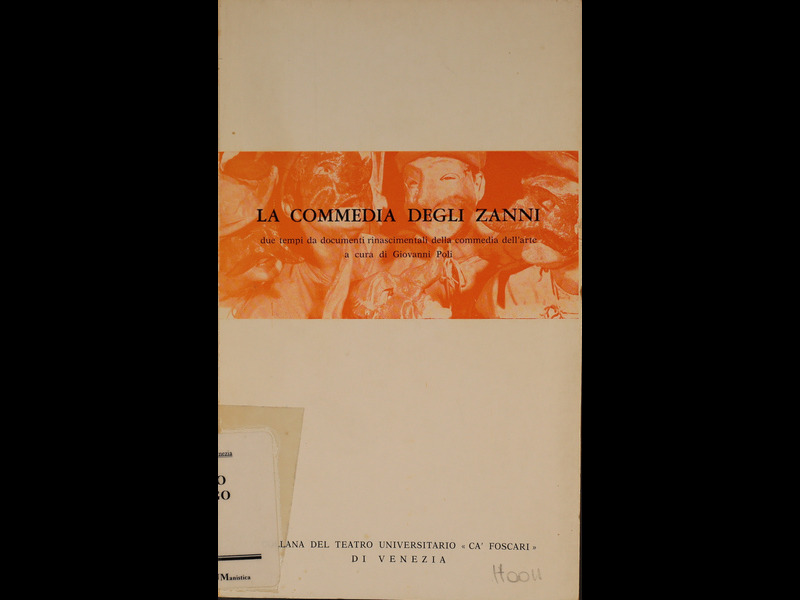
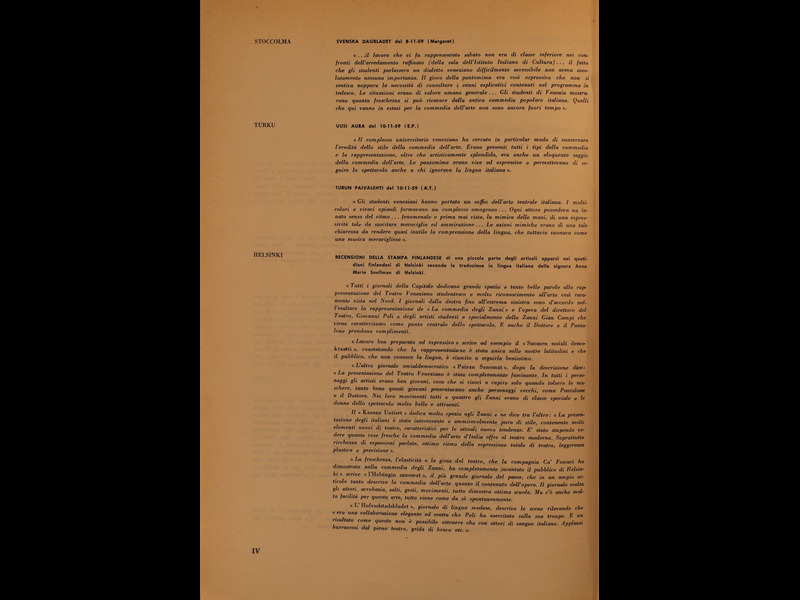
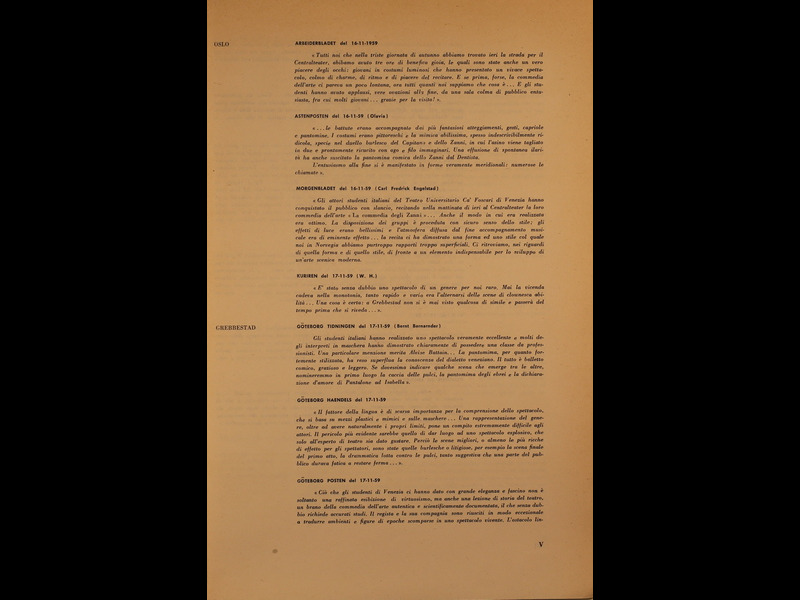
9 - Tour in Yugoslavia, 26 December 1960
During the 1960 Christmas period, La Commedia degli Zanni toured to Zagreb. On display here is a letter written by Giuseppe Busana, father of student Carla Busana, granting her permission to travel with the Ca’ Foscari University Theatre Company to Yugoslavia. This document serves as a reminder that, in Italy, the age of majority remained at 21 until 1975—meaning that even university students required written parental consent for international travel.
Parental consent letter for Carla Busana’s trip to Yugoslavia, 26 December 1960. Archive, Wooden Boxes 19/2 Yugoslavia
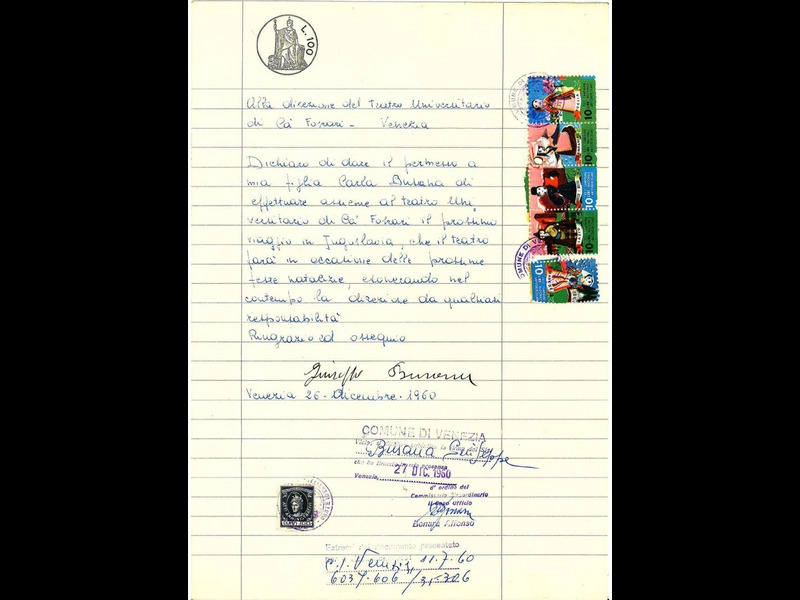
10 - Ca’ Foscari University Theatre: Official Italian Tour in Latin America, 15 July – 26 September 1962
In 1962, the Ca’ Foscari University Theatre Company embarked on its furthest-reaching tour, travelling to Latin American countries including Brazil, Uruguay and Argentina. In their own words, the performances described: “a portrait of Italian popular theatre: from the 14th-century dramatic laude, to commedia dell’arte. We explored the latter from its origins to its 18th-century decline and then in Goldoni’s reforms, continuing with its modern transformations in the world of clowns.” (p. 12)
The repertoire for this tour included: Laudes Evangeliorum, La Commedia degli Zanni, L’Augellin Belverde, Le Massere, and Tragedia e coro per dieci clown.
Upon their return, the group published the booklet shown here, which includes a brief history of Ca’ Foscari’s University Theatre, the full tour programme, a list of company members, and Spanish-language summaries of the plays performed, all accompanied by archive images and cast photographs. You can browse the full booklet on Phaidra.
Historical Collection, BG Misc B.6098

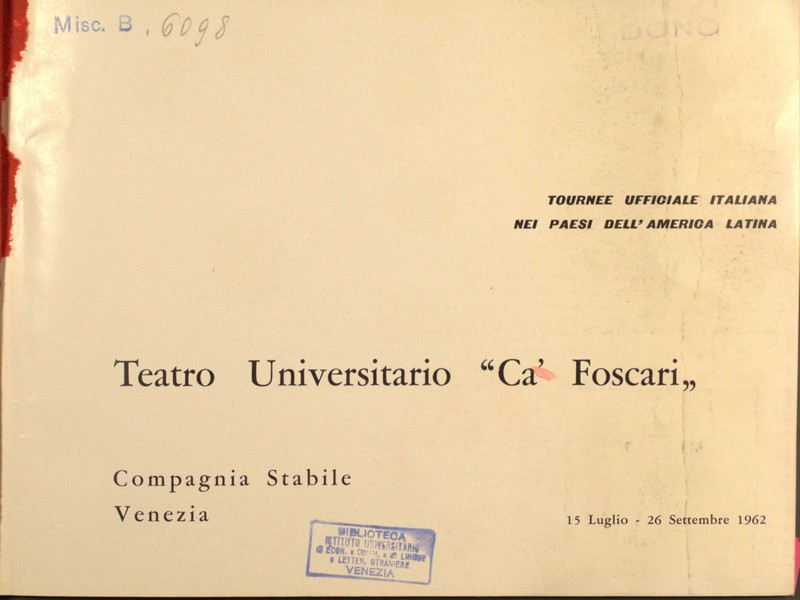
11 - Letter from Luigi Candida, 13 May 1972
Rector Luigi Candida congratulates Renato Padoan, the artistic director of the University Theatre, on the Ca’ Foscari theatre company's success in New York in April 1972 with the English-language performance of Bradisismo, a play by Franco Zardo, a former Ca’ Foscari student, translated by Brenda Balich.
Archive, Miscellaneous, University Theatre
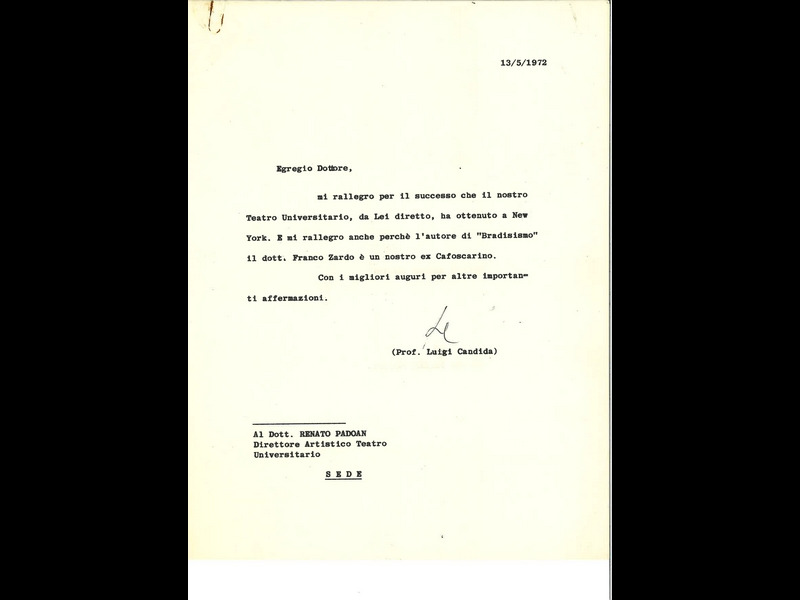
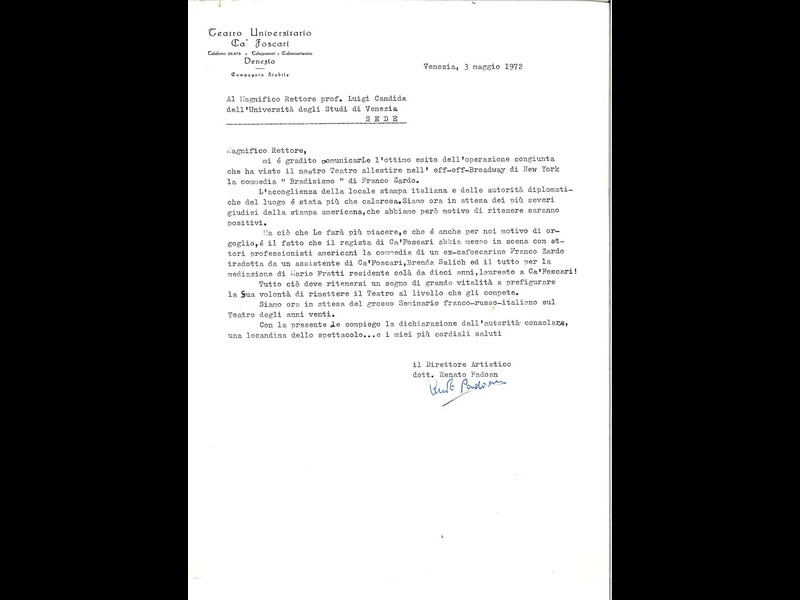
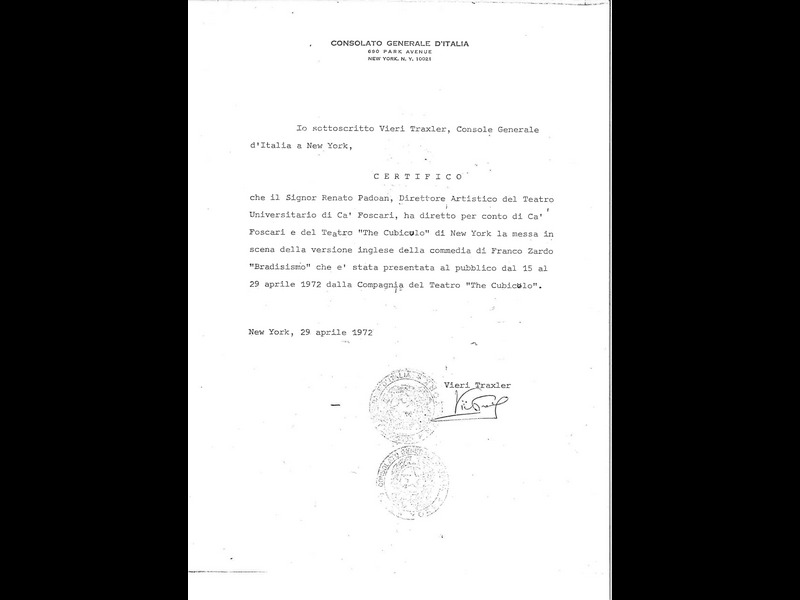
Bellini, G. (1995). Miguel Angel Asturias e Venezia. Rassegna Iberistica 54.
- Castellani, L. (2004). Giovanni Poli e il teatro di Carlo Gozzi tesi discussa a Ca’ Foscari Venezia.
- Poli, G. (Ed.). (1959). Dieci anni di un teatro Universitario : cronaca degli avvenimenti scenici e delle ricerche estetiche del Teatro universitario di Ca’ Foscari. Emiliana editrice.
- Puppa, P. (2002). s.v. Teatro, teatri. In Storia di Venezia.
- Regazzoni, S. (2018). Da Neruda, Asturias, Borges e Carpentier a Rigoberta Menchú: l’America Latina a Ca’ Foscari. In A. Cardinaletti, L. Cerasi, & P. Rigobon, Le lingue occidentali nei 150 anni di storia di Ca’ Foscari (p. Chapter_2087). Fondazione Università Ca’ Foscari.
- Scannapieco, A. (2006). Il teatro di Ca’ Foscari. Il poligrafo.
- Scannapieco, A. (2012). Il teatro di Ca’ Foscari : breve storia per immagini. Università Ca’ Foscari.
Past exhibitions
| Ca’ Foscari and the Resistance: Stories of Ca’ Foscari Partisans January-June 2025 | 2.18 M | |
| Eastward Bound: Marco Polo's Journey through Ca' Foscari's Archives August-December 2024 | 1.63 M | |
| Memories of Women between the 19th and 20th Centuries January 2024 - August 2024 | 2.39 M | |
| Ca' Foscari historic and academic venues. Restoration meets sustainability June - December 2023 | 3.08 M | |
| Student unrest at Ca' Foscari: 1967-1978 May 2021 - January 2022 | 1.32 M | |
| Women at Ca' Foscari February 2020 - May 2021 | 1.49 M | |
| Ca’ Foscari and Japan: 1868-1945 June 2019 - April 2020 | 1.34 M | |
| Two Antique Portolan Charts January-May 2019 | 292 K | |
| Statistics at Ca’ Foscari: Debate, Research and Teaching May 2018 - December 2018 | 508 K | |
| Ca’ Foscari’s Centenary: 1868 - 1968 August 2017 - April 2018 | 291 K | |
| Feliciano Benvenuti for the centenary of his birth October 2016 - July 2017 | 190 K | |
| Student life April - November 2016 | 0.93 M | |
| Ca' Foscari Illustrious guests November 2015 - March 2016 | 246 K | |
| Birth of the Royal School of Commerce May - October 2015 | 131 K |

